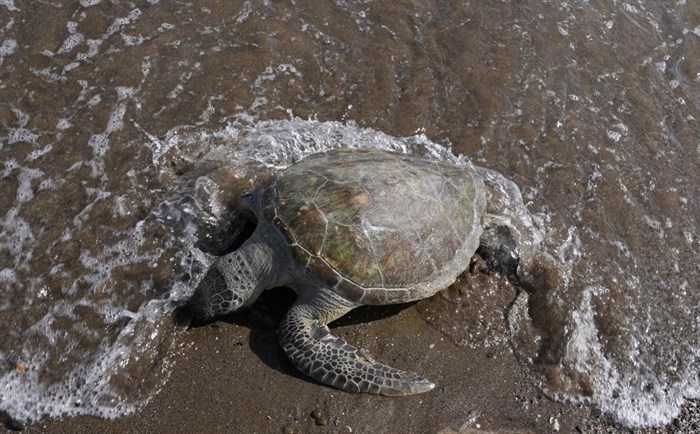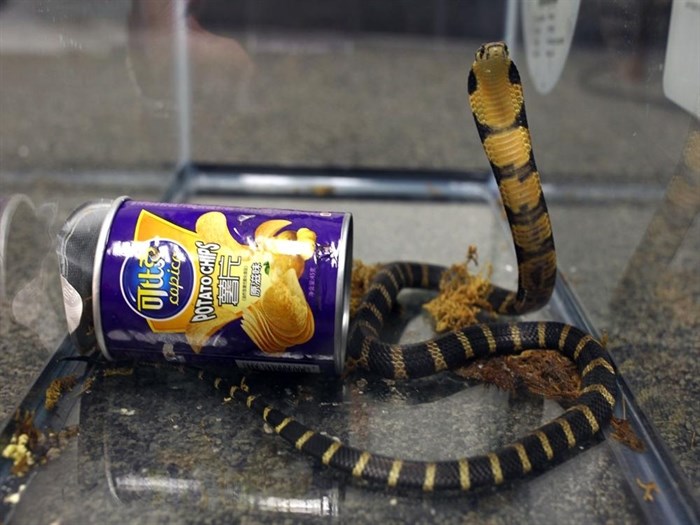
FILE - A dead green sea turtle washes up on the beach in the Khor Kalba Conservation Reserve, in the city of Kalba, on the east coast of the United Arab Emirates, Tuesday, Feb. 1, 2022. More than one in five species of reptiles worldwide, including the green sea turtle, are threatened with extinction, according to a comprehensive new assessment of thousands of species published Wednesday, April 27, 2022, in the journal Nature.
Image Credit: (AP Photo/Kamran Jebreili, File)
April 27, 2022 - 7:00 PM
WASHINGTON (AP) — Even the king cobra is “vulnerable.” More than 1 in 5 species of reptiles worldwide are threatened with extinction, according to a comprehensive new assessment of thousands of species published Wednesday in the journal Nature.
Of 10,196 reptile species analyzed, 21% percent were classified as endangered, critically endangered or vulnerable to extinction — including the iconic hooded snakes of South and Southeast Asia.
“This work is a very significant achievement — it adds to our knowledge of where threatened species are, and where we must work to protect them,” said Duke University ecologist Stuart Pimm, who was not involved in the study.

FILE - This undated photo provided by U.S. Fish and Wildlife shows a king cobra snake hidden in a potato chip can that was found in the mail in Los Angeles. More than one in five species of reptiles worldwide, including the king cobra, are threatened with extinction, according to a comprehensive new assessment of thousands of species published Wednesday, April 27, 2022, in the journal Nature.
Image Credit: (U.S. Fish and Wildlife via AP, File)
Similar prior assessments had been conducted for mammals, birds and amphibians, informing government decisions about how to draw boundaries of national parks and allocate environmental funds.
Work on the reptile study – which involved nearly 1,000 scientists and 52 co-authors – started in 2005. The project was slowed by challenges in fundraising, said co-author Bruce Young, a zoologist at the nonprofit science organization NatureServe.
“There’s a lot more focus on furrier, feathery species of vertebrates for conservation,” Young said, lamenting the perceived charisma gap. But reptiles are also fascinating and essential to ecosystems, he said.
The Galapagos marine iguana, the world’s only lizard adapted to marine life, is classified as “vulnerable” to extinction, said co-author Blair Hedges, a biologist at Temple University. It took 5 million years for the lizard to adapt to foraging in the sea, he said, lamenting “how much evolutionary history can be lost if this single species” goes extinct.

FILE - A marine iguana suns itself on the edge of a boardwalk in San Cristobal, Galapagos Islands, Ecuador on May 2, 2020. More than one in five species of reptiles worldwide, including the marine iguana, are threatened with extinction, according to a comprehensive new assessment of thousands of species published Wednesday, April 27, 2022, in the journal Nature.
Image Credit: (AP Photo/Adrian Vasquez, File)
Six of the world's species of sea turtles are threatened. The seventh is likely also in trouble, but scientists lack data to make a classification.
Worldwide, the greatest threat to reptile life is habitat destruction. Hunting, invasive species and climate change also pose threats, said co-author Neil Cox, a manager at the International Union for the Conservation of Nature’s biodiversity assessment unit.
Reptiles that live in forest areas, such as the king cobra, are more likely to be threatened with extinction than desert-dwellers, in part because forests face greater human disruptions, the study found.
___
Follow Christina Larson on Twitter: @larsonchristina
___
The Associated Press Health and Science Department receives support from the Howard Hughes Medical Institute’s Department of Science Education. The AP is solely responsible for all content.
News from © The Canadian Press, 2022